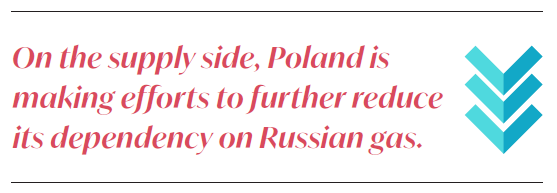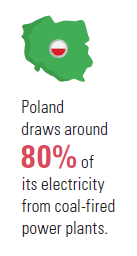Poland’s COP26 coal pledge fails to impress, but change is coming [Gas in Transition]
Poland’s decision to sign the Coal to Clean Power Transition statement at COP26 in Glasgow initially led to a fair amount of short-lived excitement. The country had previously committed to phase out coal by 2049, however the statement signed on November 4, signed by 23 countries, said the signatories would aim to achieve a transition away from unabated coal power generation in the 2030s – or as soon as possible thereafter – for major economies and in the 2040s globally. Many assumed that EU-member Poland – which has seen strong economic growth over the years – would fall into the 2030 category, but this proved not to be the case. Not long after the announcement, Polish climate and environment minister Anna Moskwa confirmed that Poland intends to phase out coal only in 2049.
This does not mean, however, that Poland’s coal addiction necessarily will continue at the current pace for much longer. It is worth noting, for example, that Poland was among 20 new countries at COP26, alongside the likes of Vietnam and Morocco, that committed to not building new coal plants.
For sure, reducing coal consumption in Poland will take time. Coal accounts for around 70% of power generation in the country and the coal mines provide jobs for thousands of people backed by strong unions. But Poland is also committed, under EU law, to reduce CO2 emissions by 55% by 2030 compared with 1990 levels and to reach net-zero emissions by 2050.
Mark Remshardt, senior analyst at Moody’s, tells NGW that it is likely the share of electricity output from coal and lignite in Poland will decrease over the next decade owing to a penetration of renewables and gas in the power mix.
“Both sources will play an important role to ensure security of supply in Poland and, in the case of gas, to provide flexible capacity to complement the intermittent nature of wind and solar output,” Remshardt explains. “Gas is also planned to replace coal as main fuel for district heating, and many of the plants to be switched to gas are co-generation plants, i.e. also produce electricity.”
The build-out of renewables, currently mostly solar and some onshore wind, is already making an impact. Around 14% of electricity generation in Poland was from non-hydro renewables in 2020, according to BP statistics. Offshore wind is expected to make an impact after 2025, with companies such as Equinor and RWE eyeing the potential in the windswept Baltic Sea. To this end, Equinor and Polenergia’s Bałtyk II and Bałtyk III projects, with a combined size of 1.4 GW, have been awarded contracts for difference (CfD) with a duration of 25 years by the Polish government. Construction could begin in 2024. Expansion of the LitPol electricity interconnector between Poland and the Baltic states would also enable Poland to import more renewable electricity by 2025.
Soaring carbon prices
The profitability of coal-fired plants is also a concern. From 2025, under EU law, capacity payments for coal-fired generators will begin to be phased out. Capacity contracts secured in national auctions provide a fixed revenue stream which comes on top of the market prices for electricity. Moreover, soaring costs of carbon allowances under the EU’s Emissions Trading System (ETS) will continue to eat into the profit margins of coal plants. Earlier this year, Polish energy company Energa confirmed that its controversial 1-GW Ostroleka C coal-fired power plant project would not go ahead. The company said in June it would invest more in renewables and gas instead.
Coal-to-gas conversion of existing plants has also begun. Poland’s largest utility PGE – whose power generation is 80% from coal and lignite – is building two CCGT units totalling 1.4 GW of capacity at its Dolna Odra coal plant. They are expected to be commissioned in 2023. Moreover, new CCGT units will replace the PGE’s existing hard coal-fired CHP plant in Siechnice although commissioning has been delayed to the second quarter of 2024. The company also says it will build new CCGTs to back up intermittent supply from a growing renewables portfolio.
On the supply side, Poland is making efforts to further reduce its dependency on Russian gas. The long-term 10bn m3/year supply contract with Gazprom via the Yamal pipeline expires next year, and Warsaw has said it will not renew it. In the meantime, state-owned incumbent PGNiG is trying to renegotiate the price with Moscow. The Swinoujscie LNG terminal, which became operational in 2016, has increased its bargaining power, but there are new projects coming on stream too. The 10bn m3/yr Baltic Pipe will bring Norwegian gas to Poland via Denmark and is now expected to be fully operational in early 2023. The planned 4.5bn m3/yr Gdansk FSRU, which is backed by the EU, would further diversify supplies although a final investment decision (FID) has not yet been taken.
The nuclear wildcard
France’s EDF has announced plans for building nuclear power plants in Poland – between four and six EPR reactors. But with high upfront costs and the delays and cost overruns for EPR reactors witnessed in Finland and France, it is not a given that these projects will go ahead.
“The nuclear plans in Poland are at an early exploration stage and indeed EDF has made an offer, but the Polish government has also been in talks with the US around building and funding nuclear capacity,” says Remshardt.
He notes that the designated special purpose vehicle (SPV) for the project has been fully and directly state-owned since March 2021, and that Poland is one of the supporters of including nuclear energy in the EU taxonomy.
“All of this indicates that Poland is very serious about adding nuclear to its domestic capacity mix, but it is difficult to gauge the societal acceptance of this technology,” he said. “In any case, should nuclear reactors be built in Poland, they will not change the country’s capacity mix before the decade starting 2030.”
Poland was not the only coal-dependent European country to sign a phase-out declaration at COP26. Notably Ukraine joined the Powering Past Coal Alliance (PPCA) during the summit and Kyiv pledged to phase out coal by 2035. Ukraine has the third largest coal fleet in Europe after Germany and Poland. DTEK, the biggest private investor in Ukraine's energy sector, also joined the PPCA, committing to powering operations without coal by 2040. Around 30% of power generation in Ukraine is from coal, compared with around 10% from gas, according to BP statistics.
However, Ukraine’s coal fleet is very old; the plants were built in the 1960s and early 70s. Many of them have already exceeded their technical lifespan, but the 2035 phase-out nevertheless implies that new ones will not be built. The Ukrainian government also plans to continue to close unprofitable mines. An in-depth plan on how to do so is to be developed by September 2022, according to a recent report by Low Carbon Ukraine.



